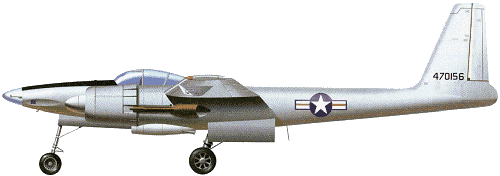|
| Designed specifically for long-range photographic reconnaissance, the Hughes XR-11 (formerly XF-11)
twin-engined, twin-boom monoplane flew for the first time on 7 July 1946 but lost a propeller,
the flight ending in a crash that nearly cost pilot Howard Hughes his life. A second aircraft flew on 5 April 1947 and subsequently went to Eglin Field, Florida (now Eglin Air Force Base), to be tested, but the US Air Force cancelled the programme in favour of utilizing the much more economical Boeing RB-50 to meet the long-range photo-reconnaissance requirement. FACTS AND FIGURES ® The XF-11 had a two-man
cockpit and a large camera nose.
Unlike the XF-12 there was no
room for onboard film processing. ® The first XF-11 had eight-bladed
contra-rotating propellers with
reversible pitch. It is thought
that the rear propeller on the
starboard engine went into
reverse, precipitating the crash. ® The ailerons were small and
gave sluggish control at low
altitudes, although high-altitude
performance was very good. ® Most of the fuel
supply was carried in
the long tailbooms.

| MODEL | XF-11 |
| ENGINE | 2 x Pratt-Whitney R-4360, 2611kW |
| WEIGHTS |
| Take-off weight | 26416 kg | 58238 lb |
| DIMENSIONS |
| Wingspan | 30.90 m | 101 ft 5 in |
| Length | 19.97 m | 66 ft 6 in |
| Bill, e-mail, 06.12.2012 22:38 This plane is another example of the government not buying the best plane for the job. Does anyone know what happened to the 2nd prototype 47-1056? reply |
| Klaatu83, e-mail, 24.09.2012 15:14 The photos show the second prototype, which was built without the contra-rotating propellers which caused Hughes so much trouble. The reversal of pitch of one of those contra-rotating props caused the crash of the first prototype, nearly killing Hughes.
There was no relation between the P-38 and this aircraft, except for the fact that they shared the same basic twin-boom configuration. The F-11 was not a fighter, it was specifically designed to be a long-range, high-altitude, high-speed photo-reconnaissance platform. Apart from everything else, with a take-off weight of over 58,000 pounds, it would have been far to big and heavy ever to have been a fighter. I suppose the most appropriate comparison would be to say that this was aircraft was meant to have been the SR-71 of the 1940s.
The only other aircraft built to meet the AAF specification for which Hughes designed the XF-11 was the equally spectacular Republic XF-12 Rainbow, which was an even larger four-engine aircraft. reply | | norb, e-mail, 18.02.2011 04:30 Why does every nut keep on harping on it being a redesign of a p38 which was a awwaaaii fighter aircraft and a good one two. This aircraft was not designed to be a fighter! It is a high altitude recon air craft with long range capability. It was slow reaction to changes in the control surfaces and tended to slop and slide if pushed in aerobatics because of small control surfaces at low altitudes would never lend it to combat. It is a single purpose design --recon. reply | | Noprb, e-mail, 02.10.2010 07:35 The P38 saw limited use as a recon plane and had in those planes a camera mounted in the nose of the center section but is was NOT A LONG RANGE RECON plane nor cvould it fly as high. reply | |
| | +odd Eaton, e-mail, 18.12.2008 03:48 This had the longest range (5,000 mi.) highest service cieling (45,000 ft.) highest multi-engine unofficial speed (480 mph w /CR hydromatic props) and with external fuel had the greatest time aloft potencial of any piston engined aircraft made, it was an elitist dream come true! reply | | Nathan Mofield, e-mail, 14.07.2008 03:04 How did the original counter rotating props work? Like so maney of Lockheeds airframes this bird was long and sleek> I love it reply | | Maguire, 10.06.2008 15:56 Although this plane was great at high altimtudes it had poor low speed and low altitude performance. It couldn't have been used as a fighter because of its small ailerons and slow turn rate. It was designed from the D-2 to be a recon plane, nothing else. reply | | barry4900, e-mail, 17.04.2008 10:52 Obviously related to or inspired U-2 & SR-1 type operations reply | | 3VI, e-mail, 15.12.2007 12:08 It could be an excellent recon plane, maybe not a fighter and it would not to be.
Howard Hughes frequently said P-38 was an unauthorized copy of his original project (the D-2 Convoy Protector fighter), but Kelly Johnson at Lockheed started early on 1937 to design his more lucky creature. reply | | Sgt.KAR98, 20.10.2007 01:35 This plane is beautiful!
Looks like an advanced P-38!Dunno why it wasn┤t used as a fighter... reply | | Vilmar Moccelin, e-mail, 16.10.2007 15:56 Joris, the XF-11 is twice the weight and is twice the size of the P-38... The performance of the XF-11 in hi altitude is superior and the range of the Huges is far superior.
And it isn't a fighter, is the father of the U-2 and SR-71. reply | | Johnny Wickham, e-mail, 14.09.2007 19:52 Howard Hughes was a nut case, a gifted pilot & designer and probaly a genious, but still a nut case. reply | | Joris Van den Berghe, e-mail, 21.02.2007 12:36 It looks a little like a P-38 Lightning. Why should they design such a beast if the P-38 was able to do the same job? reply |
|
Do you have any comments?
|
| 
All the World's Rotorcraft |








ą¤ąŠčüčéčĆąŠąĖčéčī ą┤ąŠą╝ ą╝ąŠąČąĮąŠ ąĖ čüą▓ąŠąĖą╝ąĖ čĆčāą║ą░ą╝ąĖ. ąØąŠ, čüą║ą░ąĘą░čéčī ą┐ąŠ ą┐čĆą░ą▓ą┤ąĄ - čŹč鹊 ąĮąĄ ą▒čāą┤ąĄčé ąŠč湥ąĮčī ą▒čŗčüčéčĆąŠ, č鹥ą╝ ą▒ąŠą╗ąĄąĄ, ąĄčüą╗ąĖ čā ą▓ą░čü ąĮąĄčé ą┤ąŠčüčéą░č鹊čćąĮąŠą│ąŠ ąŠą┐čŗčéą░. ą'ą▓ąĖą┤čā ąŠčéčüčāčéčüčéą▓ąĖčÅ ąŠą┐čŗčéą░ ą┤ąŠą╝ ą▒čāą┤ąĄčé čüčéčĆąŠąĖčéčüčÅ ą╝ąĄą┤ą╗ąĄąĮąĮąŠ ąĖ ą▓ąŠąĘą╝ąŠąČąĮąŠ ą┤ąŠą┐čāčēąĄąĮąĖąĄ ąŠą┐čĆąĄą┤ąĄą╗ąĄąĮąĮčŗčģ ąŠčłąĖą▒ąŠą║. ąøčāčćčłąĄ ą┤ąŠą▓ąĄčĆąĖčéčī čüčéčĆąŠąĖč鹥ą╗čīčüčéą▓ąŠ ą┐čĆąŠč乥čüčüąĖąŠąĮą░ą╗ą░ą╝.
reply